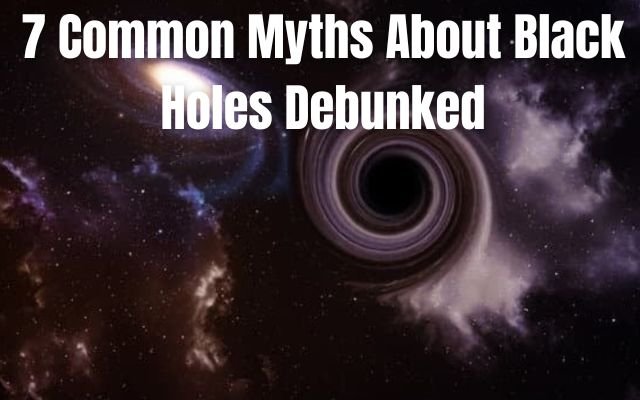7 Common Myths About Black Holes Debunked
Discover the truth behind black holes as we debunk the 7 Common Myths About Black Holes Debunked and reveal their real nature.

Black holes have long captivated the attention of scientists and general public. They are frequently depicted in science fiction as enigmatic, potent and frightening cosmic forces. Black holes are frequently misinterpreted, despite their frequent appearance in television, movies & literature. 7 Common Myths About Black Holes Debunked in this article along with the true science underlying these amazing objects.
Table of Contents
7 Common Myths About Black Holes Debunked
1. Myth: Black holes ‘eat’ everything around them
Many people imagine black holes as cosmic creatures that consume everything in their path. This is untrue, though. Despite having incredibly strong gravity, black holes don’t actively look for matter to consume. In other words these are areas of space where gravity is so intense that anything that comes near gets pulled in.
You can think of a black hole like gravitational trap, not ravenous predator. A star or planet may be absorbed if it approaches too closely and is pulled past the event horizon or the point of no return. However, black holes do not require sustenance to exist. They do not change in response to absence of material to draw in if there is nothing around.
2. Myth: Black holes are always massive in size
People frequently visualize black holes as massive structures that are larger than entire star systems. Not all black holes are enormous though some are—supermassive black holes, for example which are located in the centers of galaxies.
Black holes are sized differently. Stellar-mass black holes for instance can be quite small and originate from collapsing stars. Some have width of just a few kilometers. Astronomers have discovered black hole that is only 19 kilometers in diameter in 2019. Contrary to popular belief, most black holes are actually quite little especially when measured against supermassive black holes.
3. Myth: Anything near a black hole will inevitably be sucked in
It’s natural to believe that everything in black hole’s path will eventually be absorbed & annihilated. This is false impression, though. Black hole’s gravitational field functions in the same way as that of any other big object, such as a planet or star. Mass of the black hole & distance from it determine how strong the gravity is.
A black hole that is ten times as massive as Sun, for instance, will attract same amount of gravitational energy as star that is same mass. You can circle black hole securely without being drawn in if you’re far enough away. Indeed, some scientists think that planets may circle black holes without colliding with them; in fact, there’s even theory that life might exist on such planets. Hence, despite what the general public believes being close to black hole does not always portend disaster.
4. Myth: You can’t see a black hole
Because light cannot escape from black hole due to its extreme gravity many people think that black holes are absolutely invisible. Black holes can still be found even though nothing can escape from beyond event horizon.
By analyzing how objects near black holes behave astronomers have discovered techniques to “see” them. They see for instance how close stars appear to revolve around imperceptible objects. This frequently results in finding of black hole. One well-known example is the star S2, which circles an invisible object at galactic center that was eventually found to be supermassive black hole Sagittarius A*.
In 2019, Event Horizon Telescope even captured first-ever image of black hole, M87*. Photograph showed “accretion disk” or brilliant ring of gas and dust spiraling around black hole but it did not show black hole itself. Telescopes are able to detect radiation produced by the friction caused by materials heating up as they fall toward black hole.
5. Myth: Black holes are holes in spacetime
Despite their name black holes are not real holes/voids in spacetime. Best way to understand black hole is as place where strong gravitational forces cause fundamental laws of physics to collapse. Something is attracted into dense compact area where all of its substance is crushed when it crosses event horizon rather than falling into empty space.
Since we can’t see beyond the event horizon, we don’t really know what happens inside black holes. Some theories suggest black holes might be “wormholes” that connect different parts of space or even lead to other universes. To fully comprehend what is within black holes more research is necessary as these theories are still theoretical.
6. Myth: Black holes stay in one place
It is easy to imagine black holes as immobile objects in space that draw matter from their surrounds. However, black holes actually have the same space-moving capabilities as stars, planets and other celestial bodies. Black holes have the ability to combine with one another & can be dynamic.
2015 saw landmark discovery of the first detection of gravitational waves which are disturbances in spacetime brought on by immense cosmic events. These waves resulted from two black holes colliding & merging. This incident demonstrated the ability of black holes to move and interact with one another, sending forth ripples throughout the cosmos.
7. Myth: A black hole would kill you by crushing you
Many believe that the most dangerous aspect of falling into a black hole would be the immense pressure that crushes you. While black holes are indeed incredibly dense, the reality is more bizarre. The real cause of death if you fell into a black hole would be “spaghettification.”
As you fall into a black hole, the difference in gravitational force between your head and feet would be enormous. The closer you get to the black hole, the stronger the gravity, and because black holes have such steep gravitational gradients, the pull on your feet would be significantly stronger than the pull on your head. This difference would stretch your body out, literally pulling you apart like a piece of spaghetti. It’s this stretching effect that would kill you, rather than being crushed by pressure.
- 10 Fun and Fascinating Facts About the Sun
- 10 Fascinating Facts About Comets You Need to Know
- 5 Popular Science Facts That Are Completely Wrong
Conclusion
Black holes are undeniably some of the most fascinating objects in the universe, and their portrayal in science fiction often adds to the mystery surrounding them. However, many of the ideas people have about black holes are based on myths. By understanding the real science behind black holes, we can appreciate just how strange and wonderful these cosmic phenomena truly are. Far from being monstrous, all-consuming entities, black holes are simply regions of space where gravity is at its most extreme, and their behavior is governed by the same laws of physics that shape the rest of the universe.
This guide on 7 common myths about black holes debunked highlights how much more there is to learn about these cosmic giants, proving once again that truth is often stranger than fiction.



